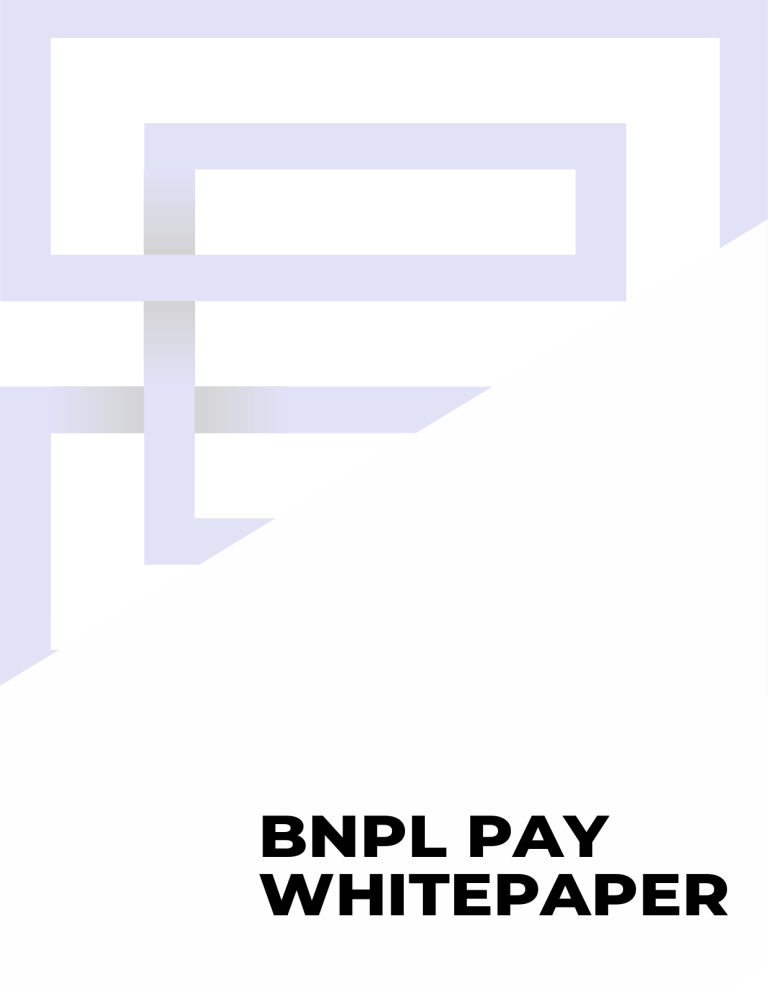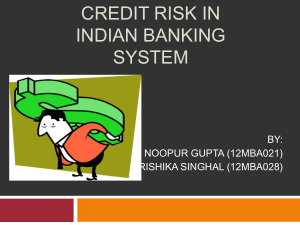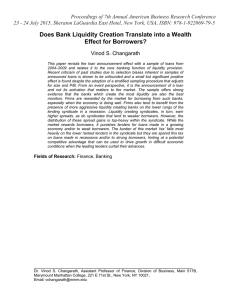
BNPL PAY WHITEPAPER Table of Contents 3 Introduction 4-5 Protocol Overview 6-7 CONTENTS BankingNode Operators PAGE 2 8 Lenders 9 Borrowers 10 Stakers 11 Example of BNPL Pay at Work 12 Risk Disclosure BNPL Pay intends to disrupt the global credit markets by creating a unique uncollateralized lending protocol. The protocol will allow users to borrow funds through its system of distributed P2P lenders run natively on the Ethereum blockchain. INTRODUCTION With the advent of blockchain technology, the credit markets have already undergone massive disruption. Currently, within the decentralized finance (Defi) and Ethereum ecosystems, the collateralized lending space has exploded, with relatively new protocols such as AAVE reaching ten figures in liquidity and borrowing. However, current protocols only support collateralized loans, limiting their users to only those with sufficient collateral. PAGE 3 On the other hand, the uncollateralized lending sector has yet to be explored and we believe this multi-trillion-dollar industry is ripe for disruption. For example, upcoming Buy Now Pay Later companies currently pay anywhere from 9% to 15% interest rates to traditional lenders, despite nominal default rates. By bridging these industries with the defi space, many synergies could be unlocked, allowing both defi yields to become more sustainable, and traditional finance (tradfi) credit to become more abundant, however, due to the complexities imposed by the credit and counterparty risk inherent within this. We believe the highest demand for credit comes from those who cannot meet the requirements to take on collateralized loans. To that end, we have created the BNPL Pay Protocol, an uncollateralized lending platform that services such a need. We tackle the counterparty risk associated with uncollateralized borrowing through a distributed network of Banking Nodes. Our system delegates the tasks of credit checks, risk assessment, and other due diligence requirements to pool operators, and creates a set of incentive structures that reward effective operators and punish ineffective ones. Banking Nodes Manage pools of liquidity and have the autonomy to delegate these funds to potential borrowers in the parameters they see fit, while lenders can choose an operator that suits their risk-reward preferences to conduct interest-bearing activities based on fully transparent data. Borrowers can apply for credit from any or all Bank Nodes and, if approved, are issued loans on fully customizable and agreed-upon terms. PROTOCOL OVERVIEW There are four key stakeholders within the BNPL Pay Ecosystem; (1) Banking Nodes, (2) Lenders, (3) Borrowers, (4) Token Stakers 1. Banking Nodes create and operate a pool of liquidity that is delegated to them from lenders. They decide how the capital is best utilized and are responsible for tasks such as assigning credit limits, interest rates, and other terms to prospective borrowers. Banking nodes broadcast all prior transactions and lending history that are summarised into easy-to-understand metrics, helping Lenders and Borrowers determine the appropriate node to interface with. To set up a Banking Node, an individual or entity must stake and lock 2M BNPL tokens. Node operators accrue 10% of the interest portion of payments made by borrowers of their pool and further staking rewards. Upon the Token Generation Event, anyone willing to bond 2M BNPL tokens will be able to set up their banking node and attract their portfolio of lenders and borrowers, thus creating a free market system that encourages competition. 2. Lenders are any protocol participant that chooses to delegate capital to a Banking Node. Within the protocol, lenders can see a transparent history recorded in the blockchain of every node operator, including stats such as total capital managed, interest accrued, average APY, total default loss, etc., as well as more detailed descriptions provided by operators on their lending procedures. Lenders will receive 70% of the interest payments made by borrowers (and principal repayments) and token emissions from our liquidity mining program. Token emissions are distributed proportionately to all lenders based on individual liquidity provided versus total liquidity on the platform. PAGE 4 3. Borrowers apply for loans from Banking Nodes. They can apply to multiple pools at no cost and are subject to the Banking Nodes' due diligence processes, such as KYC requirements and credit checks. To set up a Banking Node, an individual or entity must stake and lock 2M BNPL tokens. Node operators accrue 10% of the interest portion of payments made by borrowers of their pool and further staking rewards. Upon the Token Generation Event, anyone willing to bond 2M BNPL tokens can set up their banking node and attract their portfolio of lenders and borrowers, thus creating a free market system that encourages competition. 4. Stakers are any protocol participants that hold BNPL tokens and wish to delegate them to a Banking Node. This functions as a soft vouch for the pool operator, in return for 20% of the interest income. Stakers receive rewards in BNPL tokens, where the interest accrued is automatically converted into BNPL. In the event a default occurs, they are also subject to the same penalty as the operator and the percentage slashing penalty will be equivalent to the size of the default as a percentage of the total pool capital. Higher BNPL staked balances help mitigate risks to lenders and give them more confidence to lend to a pool. Furthermore, stakers have an opportunity to play an active role in protocol governance, where decisions such as setting protocol parameters, or changes, will be decided by these participants. PROTOCOL OVERVIEW PAGE 5 Banking Node Operators Unlike established protocols within defi, uncollateralized borrowing presents an entirely new avenue of risk that is yet to be tackled within blockchain networks, namely, counterparty risk. BNPL Pay seeks to address this risk by delegating the tasks of credit checks, risk assessment, and other processes conducted by traditional credit facilities to our node operators. Under this structure, node operators lie at the heart of our protocol and connect lenders with borrowers. Any entity can create a Banking Node, become its operator and have full autonomy of the lending operation. They are required to lock up 2M BNPL tokens, creating a vested interest in the protocol, as well as demonstrating commitment to their responsibilities. This design creates a much more open and competitive environment for lending institutions to operate in, than the current TradeFi alternative. Competition and inclusion are the necessary ingredients of innovation, something that is much needed in the credit industry. Bank Node operators compete with one another for both capital from lenders and loan requests from borrowers. BNPL.IO PAGE 6 The BNPL protocol aims to empower borrowers with more options for their financing needs, as well as access to more competitive rates. Pool Initiation and Termination In order to set up a Banking Node and become a node operator, no formal application is required. Users simply need to lock 5,000,000 BNPL tokens into a bonding contract. These tokens are locked until the termination of their node. An operator can choose to terminate their node only when all outstanding loan contracts reach maturity, at which point: Banking Node Operators • no new loans can be initiated • no new capital can enter the pool • all pool assets will be withdrawable by lenders • the bonded BNPL tokens will become withdrawable by the operator. Operator Responsibilities Node operators evaluate the different borrowers’ applications, perform the necessary due diligence and credit checks to assess risk, and assign them varying interest rates and limits based on their assessed creditworthiness and risks. Our smart contract loans will allow for maximum flexibility of loan terms such as; maturity dates, interest rates, repayment frequency, late penalties, and repayment types (interest-only vs. interest + principal). These smart contracts will allow for a fully transparent and immutable record of all loans issued, both outstanding and completed, for potential lenders to use to decide which operators they wish to delegate their funds to. The record will be summarised into easily digestible information that lenders will be able to audit to decide on a Banking Pool to which to commit their capital. Incentive Structure The incentive structure designed into our protocol and BNPL tokens, rewards node operators who perform their duties effectively, and takes punitive actions against operators that fail to carry out their duties. This is done through a fair revenue share and a penalizingslashing model. A percentage of the revenue received from interest payments will beused to reward node operators. The BNPL protocol will start with a 10% revenue share, but be subject to change based on the voting activity from BNPL stakers. (see Governance section). The interest accrued by Node Operators is only claimable upon maturity of a loan contract, regardless of the repayment schedule. PAGE 7 Additionally, Banking Node operators will also share in a further 20% interest distributed to stakers in the pool, paid in the additional BNPL tokens. Slashing Fees Slashing occurs whenever a capital loss is incurred from loan defaults. The weight of a slashing event will be relative to the total loss relative to the pool size. For example, if a pool of 2M USD incurs a 100 K loss, 5% of the staked BNPL token balance and 5% of the bonded BNPL token balance will be slashed. These tokens will be sent to a redemption contract and be claimable by lenders of their pool proportionately to their stake of lent capital. If a node operator’s token balance drops by 25% to below 1,500,000, their lending pool will undergo probation and be closed off to new lenders, as well as no longer being able to issue new loans until they top up their balance to 2,000,000 BNPL tokens. Defaults A loan is considered default if it is delinquent for over 72 hours. In such events, the capital loss is realized by the lending pool based on the outstanding principal remaining. If the node operator believes the borrower will still pay the debt after 3 days, they can apply for an extension of the default, which will be voted on by the BNPL DAO participants. In instances where loans are repaid after a default has occurred, funds are sent to a redemption contract and are claimable by lenders upon the return of the slashing fee rewards issued to them. A lender then has 90 days to redeem these funds, otherwise, they will be returned to the node operator to reimburse their slashing fee Lenders BNPLPay hopes to level the playing field for all ecosystem participants and with the BNPLprotocol, lenders will for the first time, have easy access to lending activity and interest accrual in traditional credit markets - a market that has been gated off to o Moreover, empowered by blockchain technology, lenders will have full transparency with whom they engage in business. This will allow for more effective decision-making and capital allocation. All relevant current and historical statistics of each pool will be displayed for lenders to see, including stats such as total loans issued, total liquidity committed, total tokens staked, and total default loss. They will also be able to view information on the pool’s overall strategy and procedure provided by the node operator on its landing page. BNPL Pay will develop an intuitive dashboard that summarises key statistics for lenders to scrutinize and help implement their lending strategy. Liquidity Mining BNPL recognizes lenders as core to the function of the protocol and realizes they are key stakeholders in its success. To that end, we have allocated 42.50% of the BNPL total supply to be rewarded to lenders. As such, lenders of the protocol will earn two forms of rewards; (1) Interest accrued from borrowers paid directly through the pool’s capital growth (to be paid in underlying deposit currency) (2)in token rewards paid in BNPL tokens from our emission schedule. Full CapitalUtilization Capital committed to all pools will be fully utilized, where funds not deployed to uncollateralized borrowers will be deployed onto existing collateralized lending pools such as AAVE. This will allow for consistent yields to be accrued by lenders regardless of the uncollateralized loan demand. The BNPL Pay Protocol will only use whitelisted, audited protocols that have sufficient liquidity for immediate redemption to service incoming loans, and it will be up to both the DAO PAGE 8 and node operators to select which protocols to use via BNPL’s governance model. Interest AccrualMethodology For capital lent out by the BNPL protocol to approved borrowers, interest is accrued upon each repayment made by a borrower. The protocol utilizes the conventional methodology in the legacy system breaking each repayment into interest + principal. The principal portion will go directly into the pool of funds and have no impact on the value of the pool. The interest portion received by lenders will increase the value of the pool and is realized upon each repayment. For idle capital deployed on other defi lending platforms, interest accrues in real time on a block-by-block basis. Lending and Redemption When a lender decides to commit capital to a Banking Node, their capital is added into a pool and they are given in USD tokens as receipt, representing their ownership share of the pool. At pool initiation, 1 USDT will equate to 1 bn USD token, however, the value of these tokens will appreciate as interest accrues into the pool, and decline in events of capital loss from default. Lenders can redeem bn USD tokens at any time for USDT based on the bnUSD<>USD conversion rate at the time, and subject to availability to unutilized capital within the pool. If there is insufficient liquidity, they will need to either wait for more liquidity to enter the pool, receive repayments from borrowers, or alternatively can freely trade their bUSD tokens in secondary markets. Borrowers Borrowers are the key customers that BNPL Pay seeks to service. Borrowers apply for loans from our network of Banking Nodes and are subject to their individual due diligence processes such as KYC and credit checks. They have the flexibility to shop for the best rates and terms on the market, empowering them with options outside of legacy systems. Lending and Redemption Borrowers can tailor the loan contracts to their own needs when applying for loans from various Banking Nodes, and upon getting a loan, the terms of the loan are set forth within a smart contract. It is the Borrowers’ responsibility to meet their repayment obligations. Any late repayments or failures will all be recorded in the blockchain, impacting their credit ratings and ability to access credit in the future. BNPL pay will provide templates of smart contract loan contracts that any Banking Node operator can utilize in the provision of such loans, however, more templates can be created and voted in the DAO by BNPL stakers. Within the BNPL Pay platform, there will also be a request hub for borrowers to seek loan requests from our network of Banking Nodes. Any requests submitted will be broadcast to the network allowing individual Banking Nodesto to make contact and request further information to approve these requests. Borrowers can choose to either apply for loans through this portal or directly from individual Banking Nodes. BNPL.IO PAGE 9 Stakers Stakers take on both a passive and an active role in the function of the protocol. They are key to vouching for respective pools - decreasing the risk level for lenders, as well as taking on the critical role of governance. Tokens bonded by Banking Nodes will also count as staked tokens. Vouching Vouching is the consequence of staking BNPL tokens in Banking Nodes. By staking your tokens you effectively vote and attest to the robustness of the Node you have elected to stake in. Stakers share in the gains and losses accrued by Banking Nodes, hence it is crucial to be scrutinous when deciding which Banking Node to stake. Stakers will receive a share of all revenues generated by the underlying pool and be subject to the same slashing penalties as those incurred by the node. Stakers can vouch for any pool by staking in it, and will immediately start to share in all generated revenues. To prevent gaming of the system via hopping between pools before revenue accrual, when tokens are withdrawn they will be subject to a 7-day unstaking period during which time no rewards will be accrued but slashing penalties can still be incurred. Staked Assets to Liquidity Ratio As more tokens are staked and delegated to Banking Nodes, the Nodes’ total staked value increases. This serves to mitigate the risk towards lenders, the more tokens that are staked in a Banking Node, the higher the slashing rebate to lenders in the event of a default. With this, lenders can evaluate the ratio of staked tokens to pool liquidity and compute the SATL Ratio. The SATL Ratio is defined by the following formula: Total Tokens Staked * Market Value of BNPL Tokens / Total Liquidity in Lending Pool. The higher this ratio, the higher the loss mitigation lenders will have in the event of a default. If this ratio reaches or exceeds 1.0, assuming 0 transaction costs, PAGE 10 the lenders would be compensated for any potential losses with 100% or more in losses in the form of BNPL tokens. Conversely, the lower the ratio, the larger the share of interest each staker can capture. Low ratios will maximise staking yields, and incentivise stakers with higher rewards to switchpools. This allows free market forces to determine the appropriate ratios within each pool, where lenders and stakers can capture the maximum utility. Governance All tokens staked within each banking node also are given voting rights within the protocol. Furthermore, users can choose to simply stake tokens forgovernance rights withinthe DAO without vouching for any particular node if they do not wish to take on the risks of vouching. Upon launch, multiple parameters for the protocol will be set by stakers, including details such as the splitting of revenues between Banking Nodes, lenders and stakers, as well as the loan default parameters. There will be a public forum for discussion and proposals, and all changesare subject to a vote by the BNPL Dao. BNPL Pay aims to become a fully decentralised base layer for anyone to become a credit facility, and it is up to our stakers and community to help guide and lead the future direction of the protocol. Example of BNPL PAY at Work Once the BNPL Protocol is live, there will be multiple Banking Nodes running with multiple pools. A borrower can apply for a loan from any of these nodes. Lenders and stakers will be able to lend stablecoins, stake BNPL tokens, or do both, with any of these nodes. In our example, let’suse Banking Node 1, where there is $5,000,000 USD of liquidity, 1,000,000 BNPL Tokens staked, a total of 5,000,000 Tokens Bonded, with a BNPL trading price of $1.00 per token. The SATL Ratio in this case would be 0.4. Each lender of the pool has received 1 bn USD token that is redeemable for USD at any time, at the current bnUSD/USD ratio. The starting ratio is 1:1, as 5,000,000 bnUSD tokens have been issued,and there is a total of $5,000,000 net asset value of the pool. John, the owner of a small Buy Now Pay Later company, is looking for additional finance for business operations but is struggling to get credit from traditional avenues at economically viable rates. He requires a loan of $100,000.00 USD and seeks out Banking Node 1. Banking Node 1 investigates his creditworthiness, and approves his loan at a 10% interest rate and monthly repayments over a 3 years. He would then need to make 36 monthly installment payments of $3226.72 (a total of $116,161.92 over the maturity of the loan). The liquidity pool now has $4,900,000 USD of liquidity, $100,000 of accounts receivable, and a total asset value of $5,000,000. The bnUSD/USD ratio isstill 1:1. Each installment payment will be broken up into2 portions, interest and principal. The principal and 70% of the interest is returned directly to the pool. In the first installment, $833.33 is the interest portion, and $2,393.39 is the principal. As such, $2393.39 + $583.33 is returned to the liquidity pool, where the pool now has $4,902,976.72 in liquidity, $97,606.61 in accounts receivable and a total asset value of $5,000,583.33. This gain is realized by lenders by the increase of the bnUSD/USD ratio to 1.000116666. Of the remaining interest, $166.66 (66.67%) will be converted into BNPL tokens and distributed proportionately to the providers of the 2,000,000 BNPL staked and bonded tokens, and the other $83.33 will be locked into the bonding contract of the BankingNode that is only claimable upon maturity of the loan. Scenario 1:If John Successfully Completes the Loan If John is successful in making each installment payment for the 36-month duration, the loan will be considered completed. With each repayment, the total asset value of the pool grows, and the ending asset value of the pool will grow by $11,313.35 as a result of this loan. The bnUSD/USD ratio will be 1.00226267. The staked/bonded tokens will receive 3,232.38 BNPL tokens (assuming the constant price of $1 per token), and upon completion, the Banking Node operator will have accrued $1,616.19 in interest. Scenario 2:If John Defaults In month 2, John fails to pay his installment, and his loan is considered defaulted, the following occurs; The $83.33 locked in the bonding contract will be returned to the liquidity pool, increasing the liquidity from $4,902,976.72 to $4,903,060.05, and the accounts receivable will be written off to 0, reducing the total asset value to 4,903,060.05. As such, the pool will incur a loss of $96,939.95, or 1.938% from this loan. With this, a slashing penalty will be applied, and 38,775.98 tokens will be slashed from the bonded and staked tokens proportionately, sold, and distributed to the lending pool. Assuming a constant $1 BNPL price, this helps mitigate the losses of lenders by 40% (equivalent to the SATL ratio), down to $58,163.97. The USD/USD ratio will then be 0.988367206. PAGE 11 RISK DISCLOSURE The BNPL Pay protocol (“Protocol”) is a set of smart contracts made available on an “as-is” and “asavailable” basis. It is not a service of any kind and you should not rely on BNPL Pay to assist you to evaluate the Protocol, assess its fitness for any purpose, or complying with any requirements. Every participant assumes all risks arising from interactions with the Protocol. BNPL Pay is not liable for any claim, damages, or other liability, whether in contract, tort, or under any other theory of liability, arising from, out of, or in connection with the Protocol. There are several risks when using the Protocol. These risks include inherent risks associated with the use of a virtual platform, the decentralized nature of the platform, and participating in virtual asset transactions. Risks include, without limitation; Partial or total loss of virtual assets; Collapse in liquidity with respect to virtual assets; changes in the compatibility of a virtual asset with the Protocol, changes in the smart contracts; Regulatory uncertainty and government action against virtual assets; Extreme volatility; Possibility of market misconduct by participants including for example market manipulation, trading on the basis of non-public information, and front running; Delays in or complete failure of virtual asset transactions being confirmed; Counterparty risk; Faults, defects, hacks, exploits, errors, or unforeseen circumstances occurring in respect of the platform or the technologies that the platform depends on; Loss of private keys; and PAGE 12 Attacks on the platform or the technologies that the platform depends on including for example distributed denial of service, sybil attacks, phishing, social engineering, hacking, smurfing, malware, double spending, majoritymining, consensus-based or other mining attacks, misinformation campaigns, forks, and spoofing. This list of potential risks is not exhaustive and is not intended to capture the extent of all possiblerisks. In the event of any of the above occurring, you may lose your virtual assets entirely. Participants should consider all of the above and assess the nature of, and their own appetite for relevant risks independently and consult their advisers before making any decisions in participating in the Protocol.




